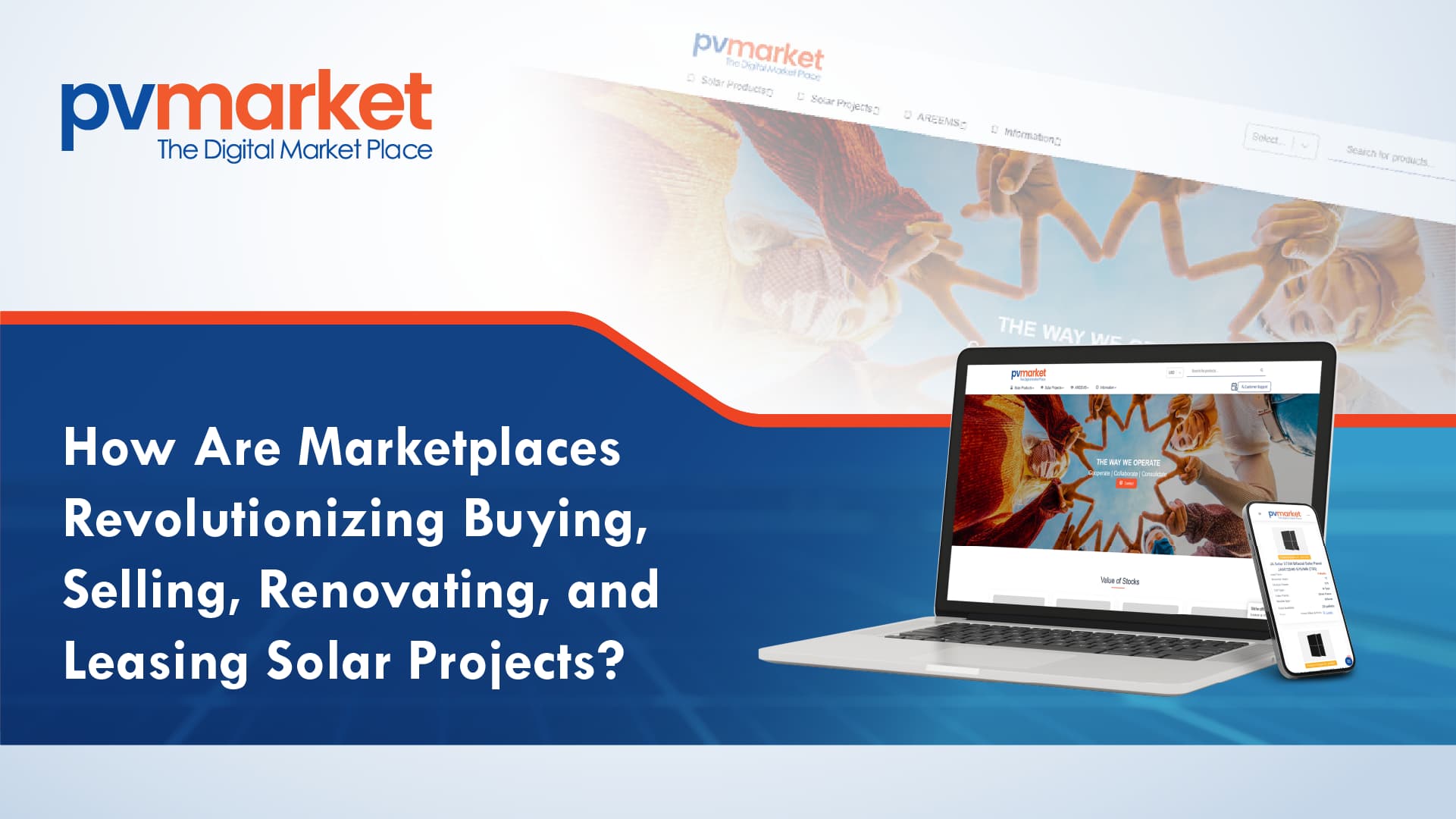Knowledge Base
How Are Marketplaces Revolutionizing Buying, Selling, Renovating, and Leasing Solar Projects?

With global solar capacity now exceeding 1,400
GW as of 2025, the bottleneck in the energy transition is no longer
manufacturing, but efficient deployment, scalability, and liquidity of assets.
Solar marketplaces are emerging as transformative platforms connecting
developers, EPCs, investors, lenders, and asset managers—especially in
high-growth regions like the MENA region, Sub-Saharan Africa, South Asia, and
Southeast Asia.
|
Region |
Capacity (GW) |
|
Global |
1,400+ |
|
India (South Asia) |
95 |
|
Vietnam (Southeast Asia) |
20 |
|
MENA (e.g. UAE, Egypt,
Morocco) |
18 |
|
Sub-Saharan Africa |
15 |
Table 1: Installed Solar PV Capacity (2025)
In this post, we explore how these digital
ecosystems are reshaping the energy landscape through cross-border investment,
faster transactions, and smarter asset management.
The Marketplace Model: What's New?
A solar marketplace is a digital platform
that aggregates clean energy projects and connects:
- Developers seeking capital or exit opportunities
- Investors seeking risk-screened energy assets
- EPC
and O&M providers for project execution
and upgrades
- Asset
owners exploring PPAs, leasing, or revenue enhancement
Common platform features include:
- Verified
project listings with financial & technical metrics
- ROI
calculators and payback estimation tools
- Legal
templates (PPAs, EPC contracts)
- Cross-border
deal facilitation
- Real-time
performance dashboards
Regional Trends & Impact
MENA Region: From Mega Projects to
Market Flexibility
- Installed
solar PV (2025): ~18 GW
- Growth
hubs: Saudi Arabia, UAE, Egypt, Jordan,
Morocco
- Policy
drivers: Green hydrogen, auction schemes,
climate finance
|
Region |
Marketplace Impact |
|
MENA |
Cross-border deal facilitation |
|
Sub-Saharan Africa |
Risk screening + portfolio bundling for mini grids |
|
India |
P2P trading, SME underwriting via platforms |
|
Bangladesh |
Microgrid refinancing through marketplace models |
|
Southeast Asia |
C&I leasing and refinancing tools |
Table 2: Marketplace Activity Highlights
Marketplace Outcomes:
- GCC-based
platforms are facilitating Egyptian and Tunisian project listings for UAE
investors.
- A 5 MW
C&I project in Oman sold in under 30 days via pv.market, after 9
months of failed direct outreach.
- Dubai’s Shams
program is scaling residential leasing; marketplaces now automate
contract and payment flows.
Sub-Saharan Africa: Unlocking
Distributed Solar at Scale
- Installed
capacity (2025): ~15 GW across all the 54
independent countries
- Key
markets: South Africa, Kenya, Nigeria, Ghana,
Ethiopia
- Segment
growth: Mini-grids, Agri-solar, commercial
rooftop
Marketplace Outcomes:
- 100 kW
to 1 MW mini-grids with PPA histories are now being sold—once considered
unbankable.
- In Kenya
and Ghana, template PPAs have cut deal timelines from 4 months to just 4
weeks.
- Bundled
asset portfolios (e.g., 20+ off-grid assets) are attracting ESG and DFI
capital.
|
Metric |
Before Marketplace |
After Marketplace |
Change (%) |
|
PPA Deal Finalization Time |
~4 months |
~4 weeks |
-75% |
Table 3: Transaction Timeline Reduction via
Marketplaces
Example: A
Nigerian startup sold five hybrid mini grids (~2.5 MW total) via a marketplace,
securing expansion capital from a European green fund for 12 additional
villages.
South Asia (India, Bangladesh, Nepal)
- India’s
solar capacity (2025): ~95 GW
- Rooftop
+ C&I: ~40% of new installations
- Bangladesh: Rapid growth via IDCOL and World Bank programs
Marketplace Outcomes:
- In
Gujarat and Maharashtra, P2P trading pilots are live, connecting surplus
solar producers directly with consumers.
- SME
rooftop projects (25–200 kW) are being underwritten via risk-scoring tools
on marketplaces.
- Various
third-party company platforms are aggregating 50+ rooftops into investable
portfolios.
Bangladesh Highlight: Over 15 MW of microgrids were refinanced through a digital
marketplace model under the IDCOL program.
Southeast Asia: Accelerating ROI and
Access
- Vietnam
(2025): ~20 GW (primarily utility-scale)
- Philippines: Strong rooftop leasing demand
- Indonesia: C&I solar-as-a-service is scaling
Marketplace Outcomes:
- Aging
utility-scale assets in Vietnam are being refinanced with
production-backed listings.
- In the
Philippines, marketplaces cut PPA negotiation time by 40–60%,
boosting commercial uptake.
- Indonesia
sees growth in modular 1–5 MW industrial park projects under
solar-as-a-service models.
Data Point:
As of early 2025, over 300 MW of C&I solar projects are listed
across leading SEA platforms.
Beyond the Transaction: Building Ecosystems
Solar marketplaces now offer:
- Monitoring
dashboards for performance validation
- Automated
ESG reports aligned with SFDR, EU taxonomy,
and IFC standards
- Blended
finance matchmaking with climate bonds and
green loans
- Risk
mitigation tools including third-party audits,
production insurance, and smart contracts
Platforms like pv.market that
feature:
a. Transparent pricing with competitive rates
b. Immediate availability and guaranteed on-time delivery
c. Wide selection of premium, top-tier brands, backed by Tier 1 manufactures
d. Real-time bidding – Bid and secure your desired products
e. A one-stop solution for all renewable energy products and services
f. Real-time price guidance with up-to-date PV spot prices
The pv.market is collaborating with IFC, EIB, and USAID to
de-risk investments in frontier markets and streamline due diligence.
Conclusion: Marketplaces as the
Connective Tissue of Solar Growth
In regions with volatile grids,
inconsistent regulation, and scattered developer networks, marketplaces offer
one critical thing: structure. They build trust, ensure documentation
consistency, and unlock new capital streams.
By 2030, solar marketplaces are projected to manage:
- 15–20% of global secondary market trades
- $75
billion+ in clean energy leasing
- A majority
share of off-grid PPAs in Africa and South Asia
For developers, they offer exits. For
investors, streamlined entry. For emerging economies, a smarter path forward.